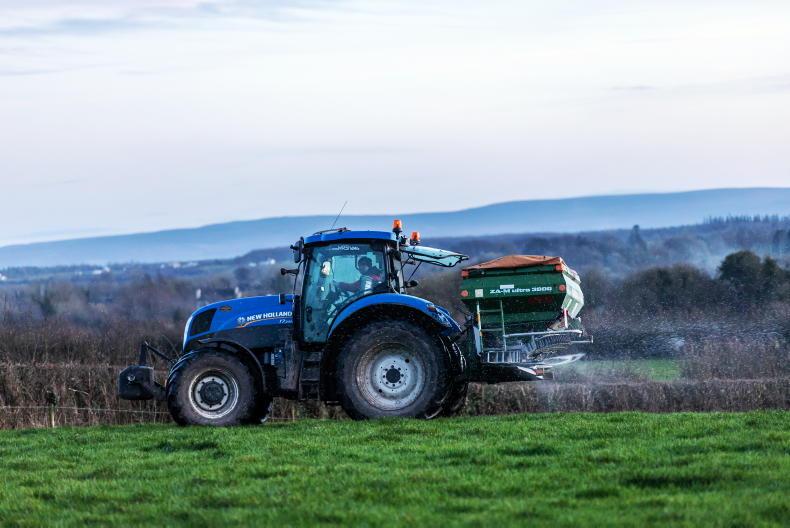After an extremely wet March, many farmers are behind on where they would like to be regarding fertiliser spreading.
How much nitrogen that should have been spread to date is all very academic. The bottom line is that each farm has a different target based on stocking rate and how likely they were to have had cows out grazing in February and March.
There is no point in spreading any nitrogen before now if, even in a dry spring, it was unlikely to have cows out grazing any more than a handful of days in the spring.
But we’re passed that now and most farmers, even those on dry land should be able to look ahead and say with some degree of certainty that the grazing season starts now.
Again, it’s difficult to be prescriptive around how much nitrogen to spread from now on as each farm is different.
Presuming the farm is fairly well stocked and that the aim is to maximise grass growth, then I would apply between 30 and 40 units/acre of nitrogen now on the grazing block where no nitrogen has been spread yet this year.
Chemical nitrogen
On fields that have got either slurry or chemical nitrogen in February or early March, I would apply no more than 30 units/acre of nitrogen now.
Clover contents shouldn’t really come into the equation until next month – for now the mainstream advice is to treat all paddocks the same but to cut back to half rate nitrogen on the high clover fields next month.
Not everyone agrees with this policy and there some really good advisors who say that where clover is present no chemical nitrogen is needed. Indeed there are plenty of farmers practicing this advice and getting on well.
However, clover contents would want to be very high, soil fertility would want to be very good and in many cases there is plenty of phosphorus and potash being applied on these fields with no nitrogen.
Teagasc advice
Therefore I think that for most farmers spreading full rate nitrogen up to May and following the Teagasc advice is the best policy.
For silage ground, the general advice is to apply 80 to 100 units of nitrogen and the equivalent of three bags/acre of 0:7:30 or 2,500 gallons/acre of good slurry.
If spreading slurry, don’t forget to subtract the nitrogen component of the slurry from the chemical nitrogen that is to be spread.
In general, 2,500 gallons/acre of good slurry applied with a low emission slurry spreader will contain about 20 units/acre of nitrogen.
After an extremely wet March, many farmers are behind on where they would like to be regarding fertiliser spreading.
How much nitrogen that should have been spread to date is all very academic. The bottom line is that each farm has a different target based on stocking rate and how likely they were to have had cows out grazing in February and March.
There is no point in spreading any nitrogen before now if, even in a dry spring, it was unlikely to have cows out grazing any more than a handful of days in the spring.
But we’re passed that now and most farmers, even those on dry land should be able to look ahead and say with some degree of certainty that the grazing season starts now.
Again, it’s difficult to be prescriptive around how much nitrogen to spread from now on as each farm is different.
Presuming the farm is fairly well stocked and that the aim is to maximise grass growth, then I would apply between 30 and 40 units/acre of nitrogen now on the grazing block where no nitrogen has been spread yet this year.
Chemical nitrogen
On fields that have got either slurry or chemical nitrogen in February or early March, I would apply no more than 30 units/acre of nitrogen now.
Clover contents shouldn’t really come into the equation until next month – for now the mainstream advice is to treat all paddocks the same but to cut back to half rate nitrogen on the high clover fields next month.
Not everyone agrees with this policy and there some really good advisors who say that where clover is present no chemical nitrogen is needed. Indeed there are plenty of farmers practicing this advice and getting on well.
However, clover contents would want to be very high, soil fertility would want to be very good and in many cases there is plenty of phosphorus and potash being applied on these fields with no nitrogen.
Teagasc advice
Therefore I think that for most farmers spreading full rate nitrogen up to May and following the Teagasc advice is the best policy.
For silage ground, the general advice is to apply 80 to 100 units of nitrogen and the equivalent of three bags/acre of 0:7:30 or 2,500 gallons/acre of good slurry.
If spreading slurry, don’t forget to subtract the nitrogen component of the slurry from the chemical nitrogen that is to be spread.
In general, 2,500 gallons/acre of good slurry applied with a low emission slurry spreader will contain about 20 units/acre of nitrogen.






 This is a subscriber-only article
This is a subscriber-only article










SHARING OPTIONS: